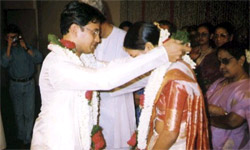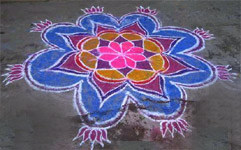Many of our customs are designed to be simple but powerful reminders or
pointers of profound philosophical truths. This is one of the factors that has
kept Indian culture alive across centuries. |
Lighting Lamp
In almost every Indian home a lamp is lit daily before the altar of the Lord. In some
houses it is lit at dawn. All auspicious functions and moments like daily
worship, rituals and festivals and even many social occasions like inaugurations
commence with the lightning of lamp. Light symbolizes knowledge and darkness,
ignorance. The light is worshipped as lord himself.
Knowledge removes ignorance, just as light removes darkness. Also knowledge
is a lasting inner wealth by which all outer achievements can be accomplished.
Hence we light the lamp to bow down to knowledge as the greatest of all forms of
wealth.
|
Namaskar
Namaskar or Namaste is the most popular form of greeting in India. It is a
general salutation that is used to greet or welcome somebody and also for
bidding farewell. While doing Namaskar, both the palms are placed together and
raised below the face to greet a person. It is believed that both the hands
symbolise one mind, or the self meeting the self. While the right hand
represents higher nature, the left hand denotes worldly or lower nature. It has
also a spiritual significance of negating or reducing one's ego in the presence
of another.
|
Prostrating before parents and elders
Indians prostrate before their parents, elders, teachers and noble souls by
touching their feet. The elder in turn blesses by placing his or her hand on
their heads. Touching the feet in prostration is a sign of respect for the
age, maturity, nobility and divinity that our elders personify. It symbolizes
our recognition of their selfless love for us and the sacrifices that they have
done for our welfare. It is a way of humbly acknowledging the greatness of
another and creates an environment of mutual love and respect among people
ensuring harmony in the family and society.
|
Tilak
Tilak is a ritual mark on the forehead. This Custom
is unique to Indians and helps to easily identify us anywhere. The tilak
is usually made out of a red vermilion paste (kumkum) which is a mixture of
turmeric, alum, iodine, camphor, etc. It can also be of a sandalwood paste (chandan)
blended with musk. It is applied on
the spot between the brows which is considered the seat of latent wisdom and
mental concentration, daily after a bath and on special occasions,
before or after ritualistic worship or a visit to the temple. Married
women used to put a kunkum mark on their foreheads all the time. In many parts of
North India it is applied as a respectful form of welcome, to honour guests or
when bidding farewell to a son or relatives. The tilak or pottu invokes the feeling of sanctity
in the wearer and others.
|
Arati
Towards the end of every ritualistic worship of the
lord or to welcome an honoured guest or new wedded couple, we perform Arati.
It is performed as an act of veneration and love. To perform arti, five
small lamps called niranjanas are filled with ghee or oil and arranged in a
small tray made of metal. A wick is made out of cotton wool and placed in the
lamps. A conchshell filled with water, auspicious leaves or flowers, incense or
lighted camphor are also placed in the tray. The lamps are lit and the tray is
rotated in a circular motion in front of the deity or the person to be welcomed.
At the end of arti, we place our hands over flame and then gently touch our eyes
and the top of the head. The purpose of performing arati is to ward off evil
effects and the malefic influence of the ‘evil eye’ |
Garlanding
 Flower garlands are generally offered as a mark of respect
and honour. They are offered to
welcome the visitors or in honour to the Gods and Goddesses. The garlands are
generally made with white jasmine and orange marigold flowers. They are weaved
in thread tied in the end with a help of a knot. During the wedding the bride
and groom exchange garlands to express the desire of the couple to marry each
other. Flower garlands are generally offered as a mark of respect
and honour. They are offered to
welcome the visitors or in honour to the Gods and Goddesses. The garlands are
generally made with white jasmine and orange marigold flowers. They are weaved
in thread tied in the end with a help of a knot. During the wedding the bride
and groom exchange garlands to express the desire of the couple to marry each
other.
|
Kolams
 Kolam is an auspicious art of decorating courtyards
and pooja rooms/prayer halls in India drawn mainly by women and girls. It is
being created to welcome the day. Some women use rice flour to draw a kolam,
while others use sandstone or limestone powder. Commonly known as Rangoli but
the name of this decorating art varies with place such as Muggulu in Andhra
pradesh, Chowkpurana in Uttar Pradesh, Madana in Rajasthan, Aripana in Bihar
and Alpana in Bengal. Jhunti in orrisa. Generally, a kolam is drawn with bare
fingers using predetermined dots. The dots are either connected together to
make a pattern or loops are drawn encircling the dots to complete a design. Kolam is an auspicious art of decorating courtyards
and pooja rooms/prayer halls in India drawn mainly by women and girls. It is
being created to welcome the day. Some women use rice flour to draw a kolam,
while others use sandstone or limestone powder. Commonly known as Rangoli but
the name of this decorating art varies with place such as Muggulu in Andhra
pradesh, Chowkpurana in Uttar Pradesh, Madana in Rajasthan, Aripana in Bihar
and Alpana in Bengal. Jhunti in orrisa. Generally, a kolam is drawn with bare
fingers using predetermined dots. The dots are either connected together to
make a pattern or loops are drawn encircling the dots to complete a design.
|
Tradition 'n' Customs for Women |